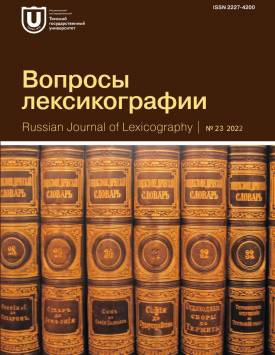Phonetic information in Russian-German and German-Russian dictionaries compiled in Germany in the 19th century
The article presents the results of the study of phonetic information provided in Russian-German and German-Russian dictionaries which were compiled in Germany in the 19th century. The relevance of this research is determined by the lack of metalexicographic works on a detailed analysis of this issue. According to their title pages and prefaces, most of the Russian-German and German-Russian dictionaries were addressed equally to Germanspeaking and Russian-speaking users. The comparative study applied in this research shows how German lexicographers meet the need of both target groups for pronunciation information. In the course of the research, we studied the bilingual Russian-German and German-Russian dictionaries in relation to the formats of presenting phonetic information, the sound composition of Russian and German words, and of recording their prosodic characteristics (stress). The research reveals that German lexicographers of the 19th century paid considerable attention to the elaboration of phonetic information which was presented in the analyzed dictionaries in two formats. Information on pronunciation was either shown in dictionary entries or given separately outside the lemma list in the surrounding text (in phonetic appendices and tables). The most commonly used format is the presentation of the pronunciation directly in dictionary entries. By the end of the century, phonetic information was additionally introduced in the macrostructure of the dictionaries in the form of phonetic appendices/notes or alphabet tables with pronunciation rules. The problem of the accurate representation of the sound composition of words was not acutely posed in the dictionaries. Apparently, the reason is that pronunciation in Russian and German was quite in line with spelling so that why this type of information could be basically left out. Nevertheless, in some dictionaries, this phonetic parameter found some elaboration. In most cases, the sound composition was represented only for Russian words. All Russian-German and German-Russian dictionaries indicated word stress. But in most dictionaries, stress is placed only on Russian words. Only in three dictionaries, lexicographers indicated the position of stress on words of both languages. The analysis shows that information on pronunciation recorded for Russian words was slightly more elaborated than for German ones. It means that the main target group of these dictionaries were still German-speaking users. Based on the results of the research, a conclusion is made that German lexicographers tried in their own way to meet the requirements of the users and to make their dictionaries as user-friendly as possible. This experience is very valuable and of undoubted interest for contemporary lexicography. Therefore, there is a need in further special investigations dealing with these dictionaries. The author declares no conflicts of interests.
Keywords
bilingual lexicography, Russian-German lexicography, German-Russian lexicography, phonetic information, stress, transcription, Germany, 19th centuryAuthors
| Name | Organization | |
| Akhmetsagirova Leysan I. | Kazan Federal University | leysan.ahmetsagir@mail.ru |
References

Phonetic information in Russian-German and German-Russian dictionaries compiled in Germany in the 19th century | Voprosy leksikografii – Russian Journal of Lexicography. 2022. № 23. DOI: 10.17223/22274200/23/3
